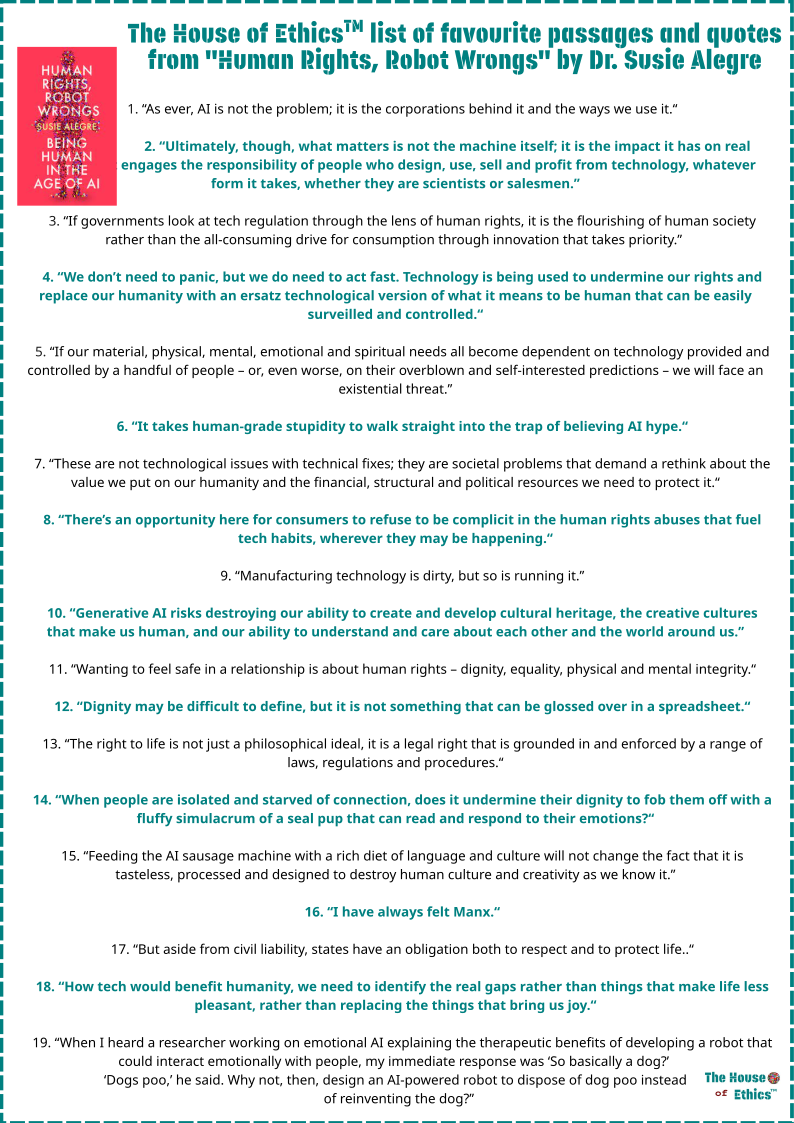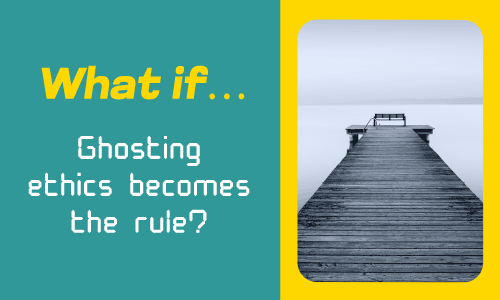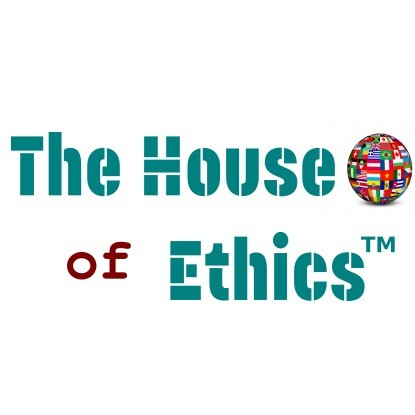“Human Rights, Robot Wrongs” by Susie Alegre. We have Read for You…
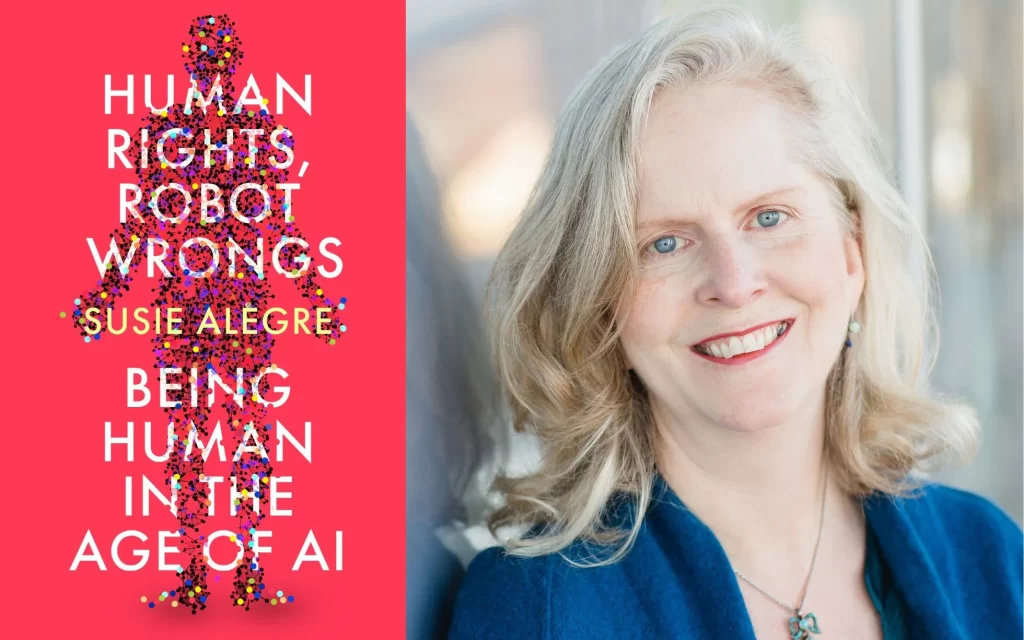
Human Rights, Robot Wrongs: Being Human in The Age of AI
Far away from being a dry and indigest legal manifesto, Human Rights, Robot Wrongs by Susie Alegre is a richly researched, techno-philosophical reflection on what it means to Be Human in the Age of AI. And what it entails for all of us to Stay Human in digital times.
The international human rights lawyer intends to demystify human rights by explaining how they are at our all reach, and can be applied in everyday life. Especially in times when our human heritage is under daily threat because of systematic technological misuses like genAI or irresponsible AI and harmful robotics. Understanding them is key. To understand how elementary and crucial universal rights are; like the right to live, the right to think, the right to dignity and the right to private and family life; the rights to a fair trial, to liberty and to equality; the right to freedom of thought, conscience, religion and belief, some rights amongst many stated in the Universal Declaration of Human Rights (UDHR) or the recent right to a clean, healthy and sustainable environment as adopted by the UN General Assembly in 2022.
In a fine mix of personal account, professional expertise and activist voicing, Susie Alegre starts in medias res on a personal note “The start of 2023 was, for me, like most creatives I know, a time of existential despair.”
Both lawyer and witness.
The author is pleading our case for humanity by referring to the existing legal tools at our disposal, mainly the UDHR. Susie Alegre methodologically exposes major risks and existing harms as well as shocking violations by showcasing numerous examples of AI and genAI failures, and how they impact humans and society at large. The author guides the reader through various fields of AI, robotics and genAI applications: from Killer Robots, to Sex Robots, to Care Bots, Robot Justice and Robot Writers/Robot Art.
The 9-chapter book opens the dialectics with “Being Human” and closes with “Staying Human”. Susie Alegre leads us through the complex legal, ethical and socio-technical labyrinth of AI-powered technology. Starting with popstar Robot Sophia, the first robot ever to gain (Saudi) citizenship, masterfully orchestrated in a worldwide PR stint by Saudi Arabia in 2017. Instead of wasting words and time on the superficial Sophia The Robot PR investment show, the author focuses on the ethical concern how a gynoid that “looks more like a drunken teenager desperately trying to look sober” and calmly stating to “destroy humans” could be promoted “UN Innovation Champion for Asia and the Pacific”. And questions how such AI-powered chip and sensor dolls like Tan Yu and Mika (both claimed first “Robot CEO”…) or Hope Sogni (‘female candidate for FIFA President) impact our human rights.
The intransigent approach of analysing the impact those technologies have on humans rather than the technology itself, all through the lens of human rights, is the stellar originality and novelty of Susie Alegre’s book.
Thus she won’t bother swimming and eventually drowning in ethical and legal muddy waters to know if AI-powered robots should have rights or not.
The author moves clearly ahead with her agenda: addressing fundamental questions of accountability and enforcement of our human rights. And the damage done! Sometimes boiling it down to the essential dichotomy between the lines : ok, “we could do it” but “should we do it”?
More so when attacking the ethical military minefield of killer robots, unmanned autonomous machines or BCIs, thus opening Pandora’s military Box of military ethics and very specific international war law, and war crimes… knowingly reminding that a fundamental human right is the right to life, and the danger that AIs cannot be found guilty of mass murder or any killing within the limits of law.
In the same breath of thought, analysing the disturbing nature of manipulative chatbots turned into “killing-me-softly bots” that disregard the golden human right: the right to life. Not only is this the case for millions of fragile teenagers but also for mentally frail adults like evoked by the example of the tragic death of Pierre, a Belgium chatbot user who committed suicide after a longer emotional attachment to chatbot Eliza.
Here Susie Alegre univocally advocates for clear lines on legal liability and the right to protect our thoughts free from manipulation.
The numerous examples put forth dramatically underline the importance and need for immediate enforcement of basic human rights. Relentlessly stressing that governments have the duty to protect their citizens’ rights.
The cases of Indian Rana Ayyub and Australian Noelle Martin victims of non-consented deepfake pornographic videos clearly show how the right to life and to private life have been compromised fundamentally. And how Australia was quick in crafting new laws to qualify non-consensual deepfake pornography as a crime. Thus protecting its citizens by law enforcement to “the right to keep [their] thoughts and inner lives private and not to be manipulated.”
Dare to Care.
In the chapter “Care Bots”, one of the most poignant chapters of the book, Susie Alegre reveals her deep sensitivity as an author, lawyer and human when walking the fine line between elder care and tech solutionism. Not only from the patients’ side but also from the carers’ perspective. Calling it a question of “safety, well-being and mostly dignity for all parties involved”.
In these complex, highly human life-and-death moments and situations multiple rights collide, such as the right to life, the right to private life, the rights to psychological and physical integrity, recalls the author.
To strike a balance between risks, harms and violations when talking about emotional AI is paramount. Susie Alegre rightfully raises the crucial issue whether robots beyond technically helping in mobility and lifting patients “are not exempting the touch of humanness which is the most important part of this specific kind of care with elderly.”
In human care techno-business, the author suggests to first identify the real gaps before filling and polluting care with unneeded and privacy compromising technology.
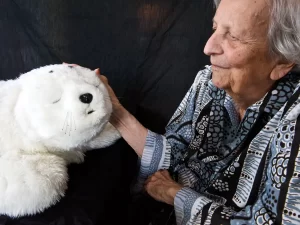 Calling to mind PARO, the interactive fluffy seal, star technology with staffers and patients in Japanese care homes. Reminding that those electronic smart toys come with sensors and mics nonstop recording patient data, thus posing a real risk to privacy and human dignity.
Calling to mind PARO, the interactive fluffy seal, star technology with staffers and patients in Japanese care homes. Reminding that those electronic smart toys come with sensors and mics nonstop recording patient data, thus posing a real risk to privacy and human dignity.
Besides privacy and dignity concerns, Susie Alegre raises concerns about another aspect of potential harm: by removing the human aspects of care work, isn’t there a risk of dehumanising both care workers and those they care for?
What about “care” when referring to “Robot Justice” to “RoboJudges” ? Why did the legal start-up “Robot Lawyer” fail? Why is the use of AI in preventing and prosecuting crimes a high risk application?
Here the author invokes on the one hand the Habeas Corpus or the right to liberty, and on the other hand, the “duty of care” to end consumers. Pointing to the staggering 69 to 88 percent where AI tools get the law wrong.
When it comes to robot writers and robot art, “duty of care” and moral rights to individual work are again totally ignored by genAI LLM models.
Article 27 of the UNHR gives writers both economic and moral rights in their work baffled by an industry-wide theft and IP violations from the manufacturers’ side.
And how most (if not all) States have failed in protecting artists worldwide, namely failed “their obligation to protect rights, including economic, social and cultural rights, and to legislate in ways that define both public and private interests in the cultural arena.”
More than a single failure, it is a systemic failure. Even the Fourth Estate, the majority of the press failed. As lately seen, most leading press institutions “dance with the genAI devil” by signing juicy deals. Exposing people to further manipulations and brainwashing, and putting our right to freedom of thought at high risk.
In this scenario of intangible and tangible heritages being under threat, Susie Alegre alerts how frail our human heritage has become when corporations and States fail to their primary duty of protecting customers, users and citizens at once. Especially when human creativity is systematically replaced by “feeding the AI sausage machine with a rich diet of language and culture will not change the fact that it is tasteless, processed and designed to destroy human culture and creativity as we know it.”
The closing chapter of Human Rights, Robot Wrongs, opens up on one of the biggest damages of AI, and in particular of genAI: their irrevocable destruction of our planet, their alarmingly energy-voracious and carbon footprint-exploding technological models. Susie Alegre, in her frank, realistic and bold style: “Manufacturing technology is dirty, but so is running it.”
“It drinks your water and feeds on exploited labour. It does not run on magical pixie dust; Any mineral that feeds our tech habit is likely bound up in environmental degradation and human rights abuses.”
In 2022, the United Nations in a UN General Assembly resolution recognized the right to a clean, healthy and sustainable environment. Right for sure, however with a “toothless” legislation regrets the author.
So, what does it mean and need to “Staying Human” ?
Human Rights, Robot Wrongs closes full circle. After a meticulous inventory and analysis, it offers solutions, hopes and perspectives.
Maybe learning from the past and capitalising on the existing. By looking at the 17th century tulipmania can we eventually learn to deal with hype? If we understand how the tulip bulbs market bubble was artificially bloated (and destroyed) on the value of a tulip going from the worth of “a townhouse to an onion”. Or during the 19th century industralisation, the UK Luddites movement fighting the motives of factory and manufacturing owners and entrepreneurs rather than innovation itself. These historical testimonies deeply resonate with our Digital Age.
Human Rights have been here for us over the last 75 years. They stem from Universal Declaration on Human Rights (UDHR) agreed by the United Nations General Assembly in 1948 after WWII, and they are “the essence of what we need to be human”, both individually and collectively. But we need to understand them in order to use them. Susie Alegre brings human rights closer to humans, on an accessible-to-all level. That’s one of the prime merits and true social services delivered to society by renowned lawyer Susie Alegre. She truly cares about educating the reader on human rights and legal tools at our disposal by using a “human” comprehensible and unifying language. Kudos! Very rare amongst lawyers…
The powerful takeaway of Human Rights, Robot Wrongs is that we are not without any means and that there is no tech determinism or fatalism but lots of human activism and action.
“We have laws, we have communities, we have moral compasses, and mostly we have the power to choose.”
Beyond all alertness and clairvoyance, we individually and collectively are able to shape our future by rightfully gearing our everyday choices and actions, as little and small as they may seem, to remain on sustainable, responsible and respectful human tracks.
“Human Rights, Robot Wrongs” by Dr. Susie Alegre, Atlantic, 224pp, £12.99
